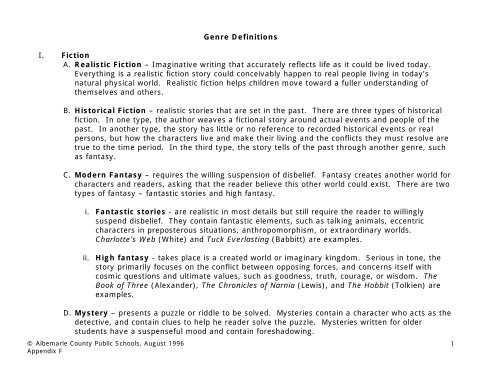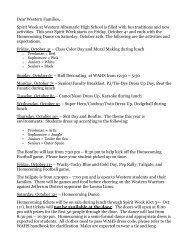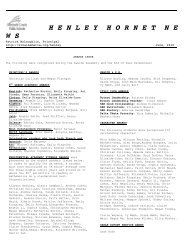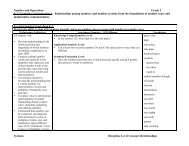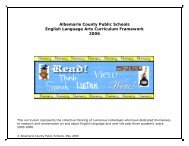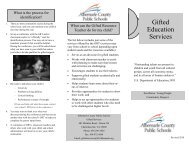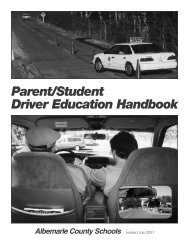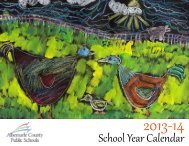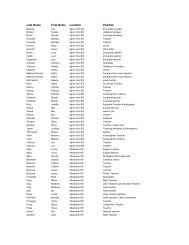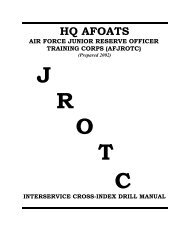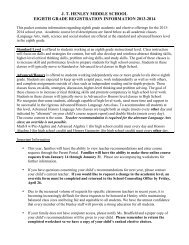1 Genre Definitions I. Fiction A. Realistic Fiction - Albemarle County ...
1 Genre Definitions I. Fiction A. Realistic Fiction - Albemarle County ...
1 Genre Definitions I. Fiction A. Realistic Fiction - Albemarle County ...
You also want an ePaper? Increase the reach of your titles
YUMPU automatically turns print PDFs into web optimized ePapers that Google loves.
© <strong>Albemarle</strong> <strong>County</strong> Public Schools, August 1996<br />
Appendix F<br />
<strong>Genre</strong> <strong>Definitions</strong><br />
I. <strong>Fiction</strong><br />
A. <strong>Realistic</strong> <strong>Fiction</strong> – Imaginative writing that accurately reflects life as it could be lived today.<br />
Everything is a realistic fiction story could conceivably happen to real people living in today’s<br />
natural physical world. <strong>Realistic</strong> fiction helps children move toward a fuller understanding of<br />
themselves and others.<br />
B. Historical <strong>Fiction</strong> – realistic stories that are set in the past. There are three types of historical<br />
fiction. In one type, the author weaves a fictional story around actual events and people of the<br />
past. In another type, the story has little or no reference to recorded historical events or real<br />
persons, but how the characters live and make their living and the conflicts they must resolve are<br />
true to the time period. In the third type, the story tells of the past through another genre, such<br />
as fantasy.<br />
C. Modern Fantasy – requires the willing suspension of disbelief. Fantasy creates another world for<br />
characters and readers, asking that the reader believe this other world could exist. There are two<br />
types of fantasy – fantastic stories and high fantasy.<br />
i. Fantastic stories - are realistic in most details but still require the reader to willingly<br />
suspend disbelief. They contain fantastic elements, such as talking animals, eccentric<br />
characters in preposterous situations, anthropomorphism, or extraordinary worlds.<br />
Charlotte’s Web (White) and Tuck Everlasting (Babbitt) are examples.<br />
ii. High fantasy - takes place is a created world or imaginary kingdom. Serious in tone, the<br />
story primarily focuses on the conflict between opposing forces, and concerns itself with<br />
cosmic questions and ultimate values, such as goodness, truth, courage, or wisdom. The<br />
Book of Three (Alexander), The Chronicles of Narnia (Lewis), and The Hobbit (Tolkien) are<br />
examples.<br />
D. Mystery – presents a puzzle or riddle to be solved. Mysteries contain a character who acts as the<br />
detective, and contain clues to help he reader solve the puzzle. Mysteries written for older<br />
students have a suspenseful mood and contain foreshadowing.<br />
1
E. Science <strong>Fiction</strong> – speculates on a world that, given what we know of science, might one day be<br />
possible. It stresses the scientific laws and technological inventions, scientific plausibility, and<br />
“future history.” What distinguishes science fiction from fantasy is that fantasy presents a world<br />
that never was and never could be, while the world presented in science fiction may one day exist.<br />
Science fiction involves the interactions between humans and scientific laws.<br />
II.<br />
Traditional Literature<br />
Traditional literature can be defined as all forms of narrative, written or oral, which have come to be<br />
handed down through the years. The time period of traditional literature is not defined, but it occurs<br />
in the past. All forms have plots and problems, often with a clear conflict between good and evil. The<br />
tales and stories usually have happy endings.<br />
A. Fables – very brief stories, usually with animal characters, that point clearly to a moral or lesson.<br />
B. Fairy Tales – tales of magic and the supernatural; usually begin “Once upon a time” and end “and<br />
they lived happily ever after.”<br />
C. Folk Tales<br />
i. Beast Tales – tales in which animals talk and act like human beings.<br />
ii. Cumulative Tales – tales that sequentially repeat actions, characters, or speeches until a<br />
climax is reached.<br />
iii. Noodlehead Stories – humorous stories that involve ridiculous, absurd happenings.<br />
iv. Pour quoi Stories – stories that answer a question or explain how animals, plants, or<br />
humans were created and why they have certain characteristics.<br />
v. Trickster Tales – tales featuring a character who plays tricks or cheats. Most well-known<br />
trickster may be coyote of Native American tales.<br />
© <strong>Albemarle</strong> <strong>County</strong> Public Schools, August 1996<br />
Appendix F<br />
2
D. Legends – stories that are similar to myth but are based on more historical truth and less upon<br />
the supernatural. Examples include Trojan War, Robin Hood, and King Arthur.<br />
E. Mother Goose and Nursery Rhymes – rhymes, including counting-out rhymes, finger plays, and<br />
alphabet verses, which originated in the spoken language of both common folk and royalty.<br />
F. Myths – stories containing fanciful or supernatural incidents intended to explain nature of tell<br />
about gods and demons of early peoples.<br />
G. Tall Tales – stories that contain exaggerations and lies. American tall tales are a combination of<br />
history, myth, and fact.<br />
III.<br />
Poetry<br />
Poetry includes written literature that is not prose. It expresses how the poet feels, makes the reader<br />
see something ordinary in a new way, and tends to be rhythmic. It includes a variety of forms and<br />
styles such as:<br />
A. Ballad – narrative poems that have been adapted for singing or that give the affect of song.<br />
Ballads usually deal with heroic deeds.<br />
B. Concrete – picture poems that make the reader see what the poet is saying. The message of the<br />
poem is presented not only in words but in the arrangement of the words. Meaning is reinforced<br />
or even carried by the shape of the poem.<br />
C. Free Verse – poetry characterized by lack of rhyme and less predictable rhythm.<br />
D. Haiku – (beginning verse) 17-syllable, delicate, unrhymed Japanese verse, usually about nature<br />
E. Limerick – five-line poems in which the first, second, and fifth lines rhyme and the third and<br />
fourth lines rhyme. Oddities and humorous twists characterize this form of poetry.<br />
F. Lyrical – poems emphasizing sound and picture imagery rather than narrative or dramatic<br />
movement. Lyrical poems emphasize musical, pictorial, and emotional qualities.<br />
© <strong>Albemarle</strong> <strong>County</strong> Public Schools, August 1996<br />
Appendix F<br />
3
G. Narrative – story poems that relate a particular event or tell a long tale. They may take different<br />
forms; the one requirement is that they tell a story.<br />
H. Nursery Rhymes – see traditional literature<br />
IV.<br />
Drama<br />
Unlike a short story or novel, a play is a work of storytelling in which the characters are represented<br />
by the actors and which is acted out on a stage before an audience. Plays typically include an<br />
introduction, rising action, climax, falling action, and resolution. The action speaks for itself as it<br />
unfolds. Important features of plays are set, stage, lighting, gesture, and oral interpretation.<br />
V. Nonfiction<br />
A. Informational Materials<br />
i. Concept Book – a book that describes various dimensions of an object (size, shape, color),<br />
a class of objects (trucks, tools), or an abstract idea (over, under, love). Counting books and<br />
alphabet books are examples.<br />
ii. Experiment and Activity Books – books that provide children with scientific experiments<br />
and activities.<br />
iii. How-to Books – books that present an array of crafts and directions to guide the reader in<br />
performing an activity.<br />
iv. Identification Books – naming books, such as Peterson’s Guide to Birds.<br />
v. Informational Picture Books – information books published in picture book format; may or<br />
may not have words.<br />
vi. Life-cycle Books – books that are structured around the life span of an animal or plant.<br />
vii. Photographic Essays – books that rely on the camera to particularize information, to<br />
document emotion, or to assure the reader of truth in an essentially journalistic way.<br />
© <strong>Albemarle</strong> <strong>County</strong> Public Schools, August 1996<br />
Appendix F<br />
4
viii. Survey Books – books that give an overall view of a substantial topic and furnish a<br />
representative sampling of facts, principles, or issues.<br />
ix. Reference Materials – materials that allow for rapid access to information. Dictionaries,<br />
encyclopedias, periodicals, and electronic media are examples.<br />
B. Biography and Autobiography<br />
Biography and autobiography provide a history of the life of an individual, with information about<br />
the time period in which the person lived. They bring a person to life in a way that is true to<br />
reality.<br />
C. Essay<br />
Essays are nonfiction prose that advance a thesis and illustrate or defend it by means of various<br />
methods of development, including definition, comparison/contrast, example and illustration, cause<br />
and effect, analysis, and argument. A good essay expresses the voice of its author while<br />
communicating its message simply, clearly, and logically.<br />
© <strong>Albemarle</strong> <strong>County</strong> Public Schools, August 1996<br />
Appendix F<br />
5
VI.<br />
Other<br />
A. Wordless Picture Books<br />
B. Pattern Books - patterns might be based on word/sentence structure, opposites, days of the<br />
week, shapes, etc.<br />
C. Graphic Novels – a narrative related through a combination of text and art, often complex and<br />
presented in a comic-book format<br />
© <strong>Albemarle</strong> <strong>County</strong> Public Schools, August 1996<br />
Appendix F<br />
6


